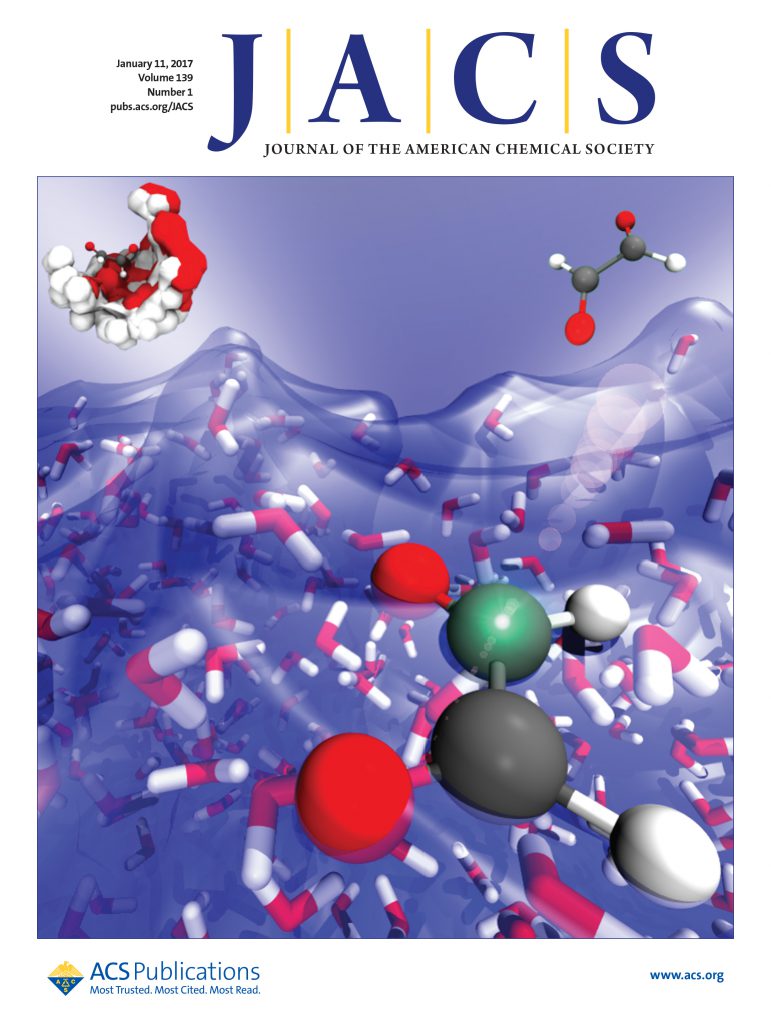Aqueous-Phase Synthesis of Cyclic Trinuclear Cluster-Based Metal–Organic Frameworks
IF 14.4
1区 化学
Q1 CHEMISTRY, MULTIDISCIPLINARY
引用次数: 0
Abstract
The synthesis of metal–organic frameworks (MOFs) often involves high-boiling-point organic solvents, which can have extensive environmental impact and limit their large-scale applications. Here, we present a one-pot aqueous-phase approach for the rapid preparation of 33 trinuclear-copper-cluster-based MOFs (1 to 33) with different pyrazoles under ultrasonic irradiation. To address the water-solubility challenge of organic linkers, we employ aromatic amines/aldehydes and pyrazole aldehydes/amines to in situ generate imine-based pyrazoles. This linker dismantling strategy enables the formation of low-concentration pyrazoles, which are essential for the assembly of trinuclear-copper-cluster-based MOFs in the aqueous phase. The use of preassembled trinuclear gold complexes instead of aromatic amines affords an Au–Cu-based MOF (34) of alternating gold and copper clusters, a rare example of MOFs with mixed yet precise arrangement of metal compositions. Additionally, the direct addition of pyruvic acid to the reaction mixture results in the facile synthesis of a carboxylic-acid-functionalized MOF (35), eliminating the need for preinstallation or postmodification steps in traditional MOF synthesis. Furthermore, we demonstrate 11-AA as an efficient photocatalyst for cross-dehydrogenative coupling (CDC) reactions, exploiting the synergetic effect of substrate activation on the copper sites and subsequent coupling initiated by the photosensitive organic linkers. This work offers a simple solution for making MOFs with minimal environmental impact; it also opens up possibilities for developing multifunctional MOFs for diverse applications.

环三核簇基金属有机骨架的水相合成
金属有机骨架(MOFs)的合成通常涉及高沸点有机溶剂,这可能对环境产生广泛的影响,限制了其大规模应用。本文采用一锅水相方法,在超声辐照下快速制备了33种含有不同吡唑的三核铜簇基mof(1 ~ 33)。为了解决有机连接剂的水溶性挑战,我们使用芳香胺/醛和吡唑醛/胺来原位生成亚胺基吡唑。这种连接体拆解策略可以形成低浓度的吡唑,这对于在水相中组装三核铜簇基mof至关重要。使用预组装的三核金配合物代替芳香胺,提供了金和铜交替团簇的au - cu基MOF(34),这是金属成分混合而精确排列的MOF的罕见例子。此外,将丙酮酸直接加入到反应混合物中,可以很容易地合成羧酸功能化的MOF(35),从而省去了传统MOF合成过程中的预安装或后修饰步骤。此外,我们证明了11-AA是一种高效的交叉脱氢偶联(CDC)反应的光催化剂,利用了底物对铜位点的激活和光敏有机连接物引发的后续偶联的协同效应。这项工作为制造对环境影响最小的MOFs提供了一个简单的解决方案;它还为开发用于各种应用的多功能mof提供了可能性。
本文章由计算机程序翻译,如有差异,请以英文原文为准。
求助全文
约1分钟内获得全文
求助全文
来源期刊
CiteScore
24.40
自引率
6.00%
发文量
2398
审稿时长
1.6 months
期刊介绍:
The flagship journal of the American Chemical Society, known as the Journal of the American Chemical Society (JACS), has been a prestigious publication since its establishment in 1879. It holds a preeminent position in the field of chemistry and related interdisciplinary sciences. JACS is committed to disseminating cutting-edge research papers, covering a wide range of topics, and encompasses approximately 19,000 pages of Articles, Communications, and Perspectives annually. With a weekly publication frequency, JACS plays a vital role in advancing the field of chemistry by providing essential research.

 求助内容:
求助内容: 应助结果提醒方式:
应助结果提醒方式:


